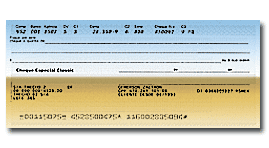| Banco Central Museum |

Bank Money - Checks
Bank money consists of demand deposits in banks and other credit institutions and checks are the instrument normally utilized to circulate bank money in an economy.
Checks can be subdivided as follows:
- those representing money delivered by the client (deposit);
- those representing credit operations (accounting deposits).
In the case of deposits made by clients, banks supply blank checks to be used according to the clientís needs until exhausting the amount credited.
Bank money is processed in much the same way as convertible paper money. Since a share of the deposits made in banks remains at those institutions, the banks lend an amount that varies between 75% and 93% of deposits to their clients, while the remainder is held in reserve. The percentages cited above vary according to the banking legislation of each country and a specific ratio among deposits, reserves and loans must be complied with.
While the French affirm that the word "check" is derived from the English verb "to check" (to verify, confer), the English claim that the origin is to be found in the French word "eschequier" meaning chessboard. According to the English, the desks used by bankers were similar to chessboards. Thus, the name. The origin of the instrument itself is even more remote and is rooted in the concept of bill of exchange.
Though specialists are not unanimous in this regard, some claim that the Romans invented the check sometime around 352 A.C.. Others defend the position that it was created in 16th century Holland. In 1500, the people of Amsterdam had the habit of entrusting their money to "cashiers", considering that there was less risk than in keeping cash at home.
The cashiers would then collect and pay debts according to written orders issued by depositors (checks).
Toward the end of the 17th century, the English developed the habit of depositing their funds with goldsmiths.(*)
On receiving the cash, the goldsmith would then issue a "Goldsmith Note" to the depositor. These were simple handwritten notes by which the goldsmith assumed the commitment to effect payment to the client or at the clientís orders.
The client could give written orders to the goldsmith requesting that payment be made to a third party.
Historians believe that the first printed checks were made by Lawrence Childs in England, in 1762. Though Childs is considered the first modern banker, the use of the check had already begun developing before he resolved to print them. However, there was a built-in inconvenience in the use of checks. Bankers would sometimes receive checks from clients against banks different from their own and would have to process them through the other institution to receive payment. As a result, they would deposit the checks in their own banks and then collect payment. Messengers would be charged with taking the checks to the other banks. As a consequence, a veritable horde of messengers spent the day crisscrossing the city in countless trips from one bank to another. Finally, the idea was put forward that the number of trips could be drastically reduced if they all met at a specific tavern and exchanged checks among themselves.
Though bankers were originally opposed to the idea, they eventually perceived the utility of the system and introduced the mechanism of Clearing Houses which are charged with the task of processing all the checks delivered to any bank against any other.
On June 14, 1865, France became the first country to approve legislation governing the use of checks. In England, where the use of the check became increasingly popular, the first legislation was enacted on August 18, 1882.
In Brazil, the first reference to the use of checks dates to 1845 with the founding of the Banco Comercial da Bahia. The word utilized to describe these papers, however, was "warrant" and not check. The use of the check is first cited in Art. 16, letter "a" of Law 149-B, dated 1893, later regulated by Decree 2,591, enacted on August 7, 1912.
There are several advantages in the use of checks: increased facility in transacting with large sums of money; savings on time since there is no need for counting money; lesser possibility of theft and, of course, lesser risk since it is no longer necessary to keep large amount of cash nearby.
In terms of security, the use of checks must be accompanied by adequate safeguards capable of generating a sense of trust among clients.
The advantages to be derived from the use of checks will only benefit those societies in which strict legislation is approved, specifying the punishment to be meted out to persons who issue checks with insufficient backing, thus ensuring public trust in this monetary instrument.
Another important type of instrument is the travellerís check, commonly used by people when traveling away from home. These instruments can be issued in any country and are signed by the beneficiary at the moment of issue. An additional signature at the time of cashing these checks ensures their authenticity.
Finally, there are special overdraft checks through which a bank guaranties that a specific balance negotiated with the client will be available at all times, independently of whether the client has deposited sufficient funding.
Notes:
(*) Persons who operated the gold trade at the time.- Text extracted from the book "Dinheiro no Brasil", by F. dos Santos Trigueiro.
 Back to the homepage Back to the homepage |